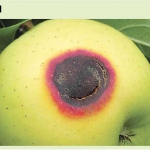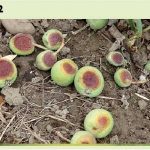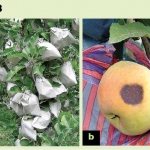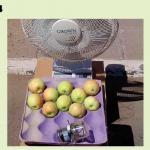Sunburn is a serious problem that affects fruits and vegetables, particularly in areas of the world where an excess of solar radiation is combined with high temperatures.
Sunburn can account for losses of up to 40 percent of the apple crop at the orchard, especially with cultivars such as Fuji, Braeburn, and Cripps Pink.
Dr. Jose Antonio Yuri, University of Talca, Chile.
In Chile, growers lose about 13.5 percent of their crop to sunburn, which amounts to more than U.S.$100 million in lost exports over the past several seasons.
The Pomological Center (Centro de Pomáceas) at the University of Talca has been studying the problem of sunburn in apples since 1992. The initial hypothesis that guided our research was that UV (ultraviolet) radiation was responsible for the symptoms.
However, a series of field observations and numerous investigations led us to conclude that sunburn in apples, under Chilean conditions, is caused mainly by elevated temperature rather than by the influence of UV radiation. Below we discuss the reasons underlying the change in our hypothesis.
—Damaged fruit is always found on the west side of the tree, affecting the side that faces the afternoon sun (Figure 1).
—Picked fruit that is exposed to the sun will experience burn damage in a few hours, while fruit that remains on the tree does not (Figure 2). This speaks of the major cooling effect of the tree on the fruit.
—Bagged fruit that has developed in darkness will burn when it has reached a very high temperature. (Figure 3).
—In laboratory tests, it was possible to induce burn damage to the fruit with a temperature of 45°C (113°F) for at least five hours. Ultraviolet radiation by itself does not have the same effect. It should be noted that in the orchard, the fruit can reach temperatures of 54°C (129°F).
—Placing different UV radiation filters (plastic, polycarbonate, or glass) over exposed fruit does not prevent fruit from sunburn. The lack of UV light resulted in less development of red color in the peel.
—Cooling detached fruit with ventilation prevents them from burning, while unventilated fruit suffer burning. The use of glass or polycarbonate did not slow the rate of damage (Figure 4).
—Burning still occurs in bioassays when solar protectors that filter UV light are applied to attached fruit, while burn does not occur when protectors that filter infrared light, like kaolin, are applied.
—Evaporative cooling is an effective way to reduce sunburn in the orchard.
Conclusions
High temperature and excess solar radiation, particularly in the infrared spectrum, are responsible for sunburn damage in apples.
The fact that the problem has become more acute in Chile in the last 20 years could be due to three factors: the incorporation of more susceptible cultivars; increasing use of dwarfing rootstocks; and more exposed training systems, such as Solaxe. The increase in ambient temperature in recent years is another factor to be considered.
Finally, we recommend the use of nets over the orchard as the best protection against sunburn, because the efficiency of protective sprays is marginal. Growers should start using protective systems when the air temperature has reached 29°C (84°F) for five hours—normally in mid-December.
Contact Dr. Jose Antonio Yuri at ayuri@utalca.cl










Leave A Comment